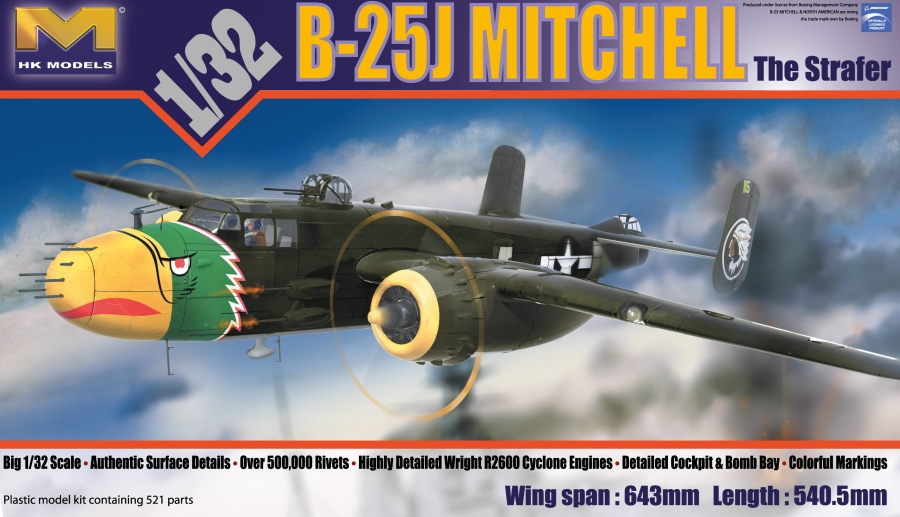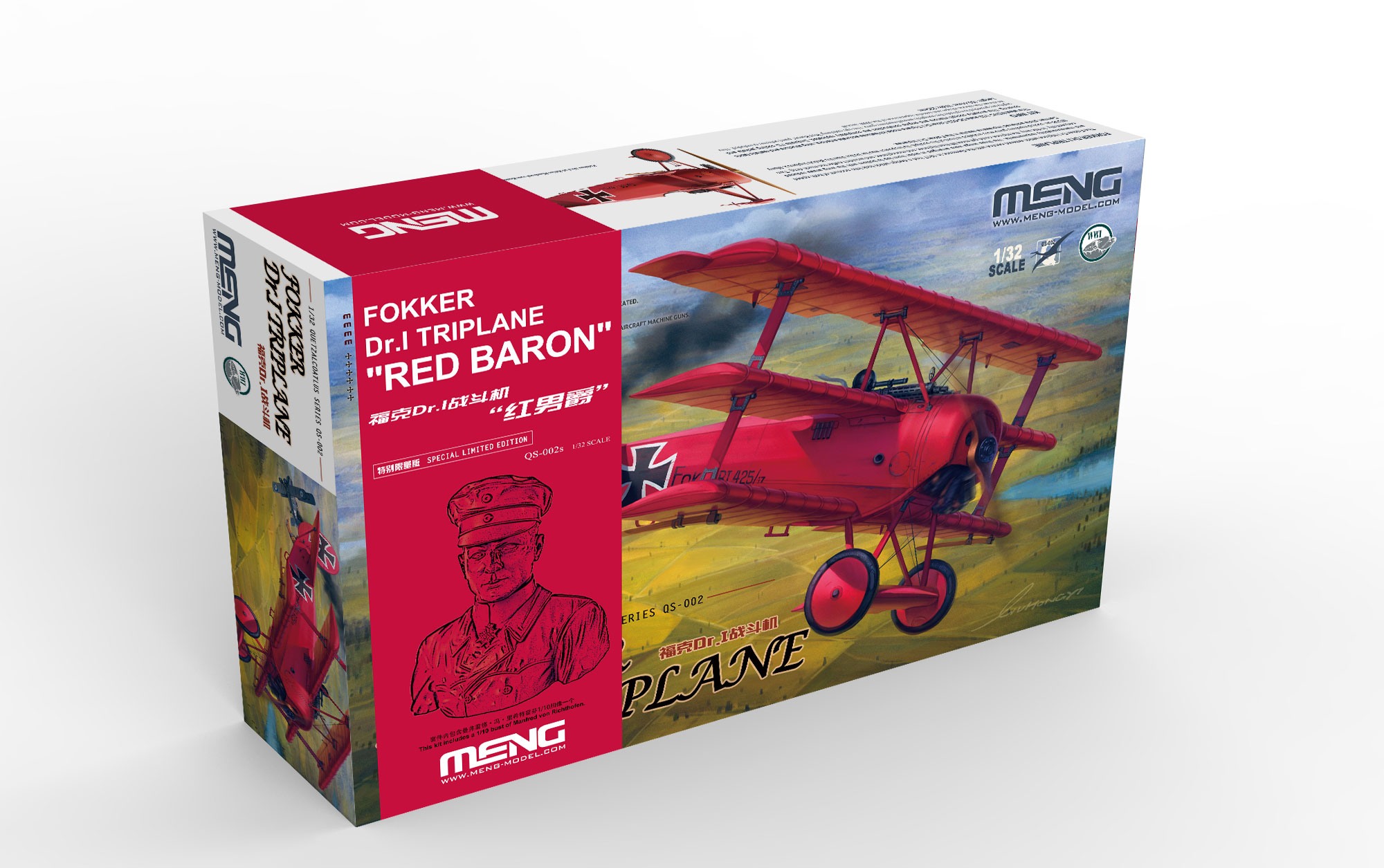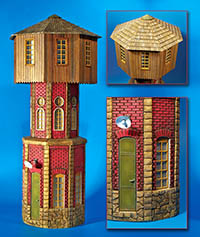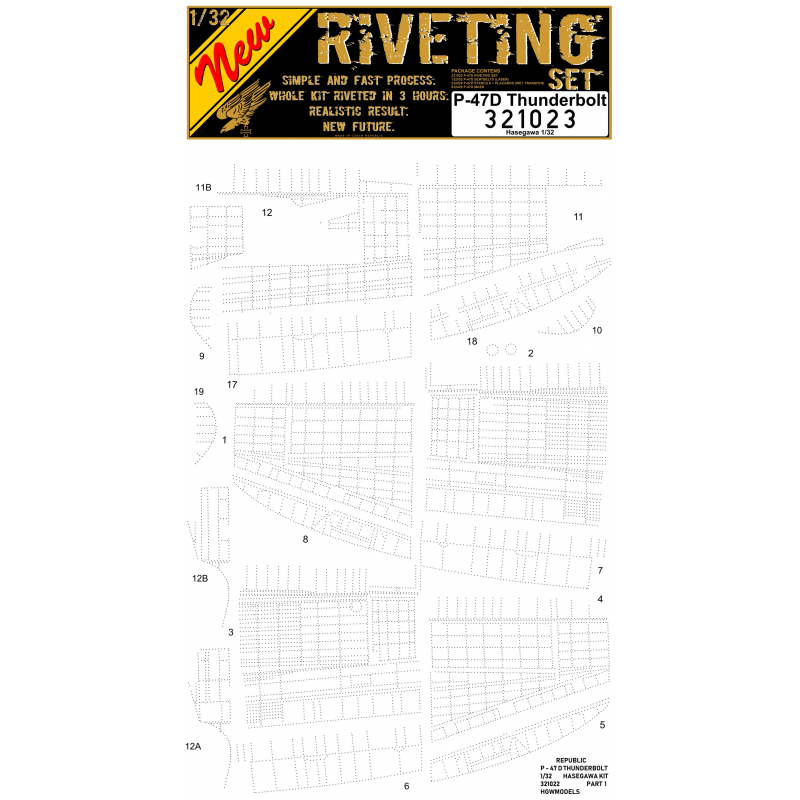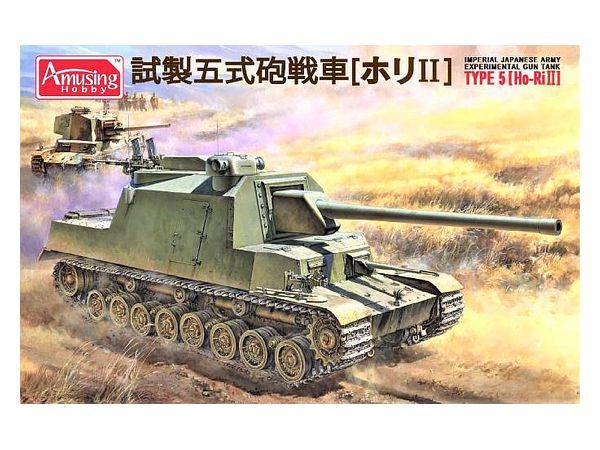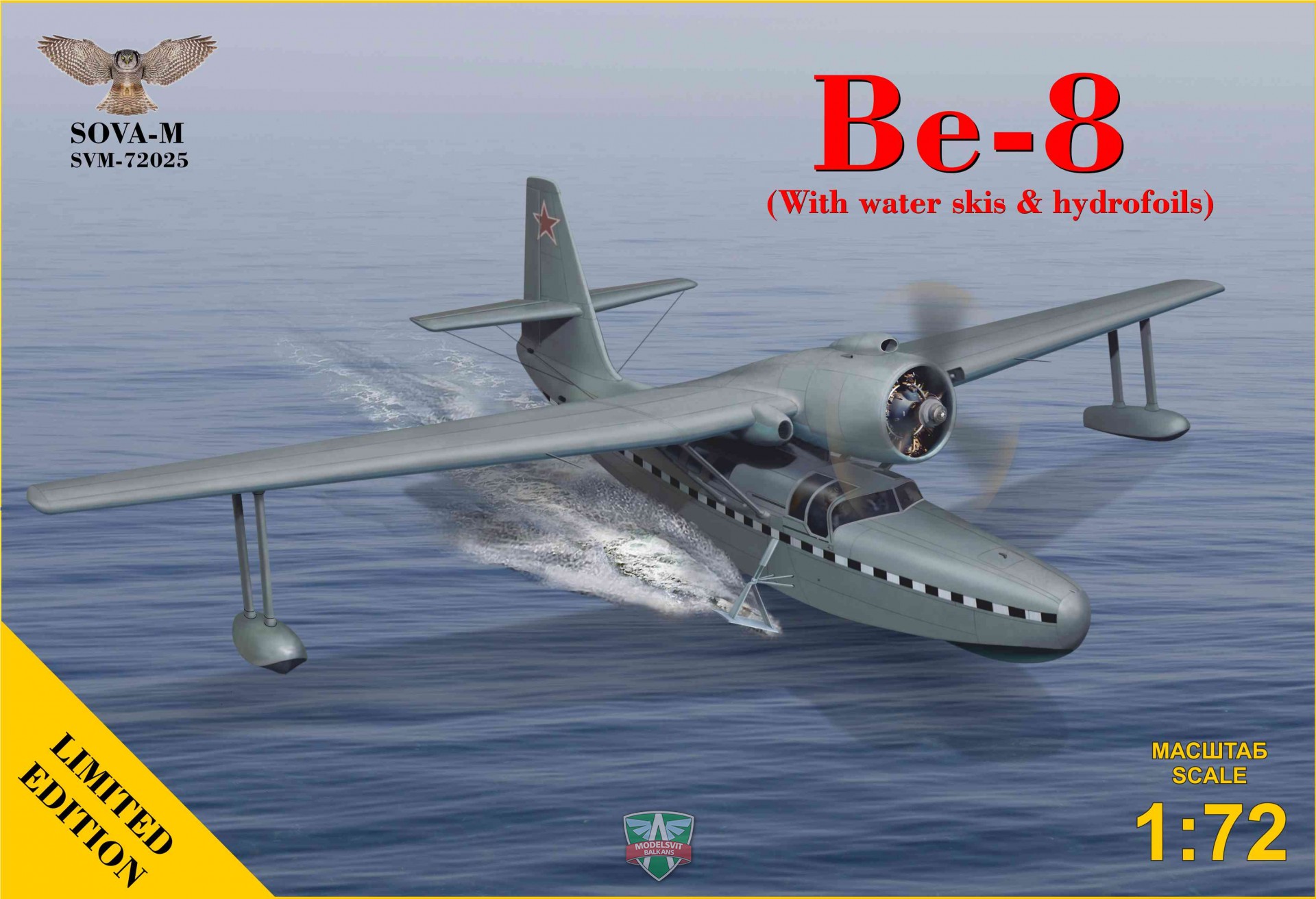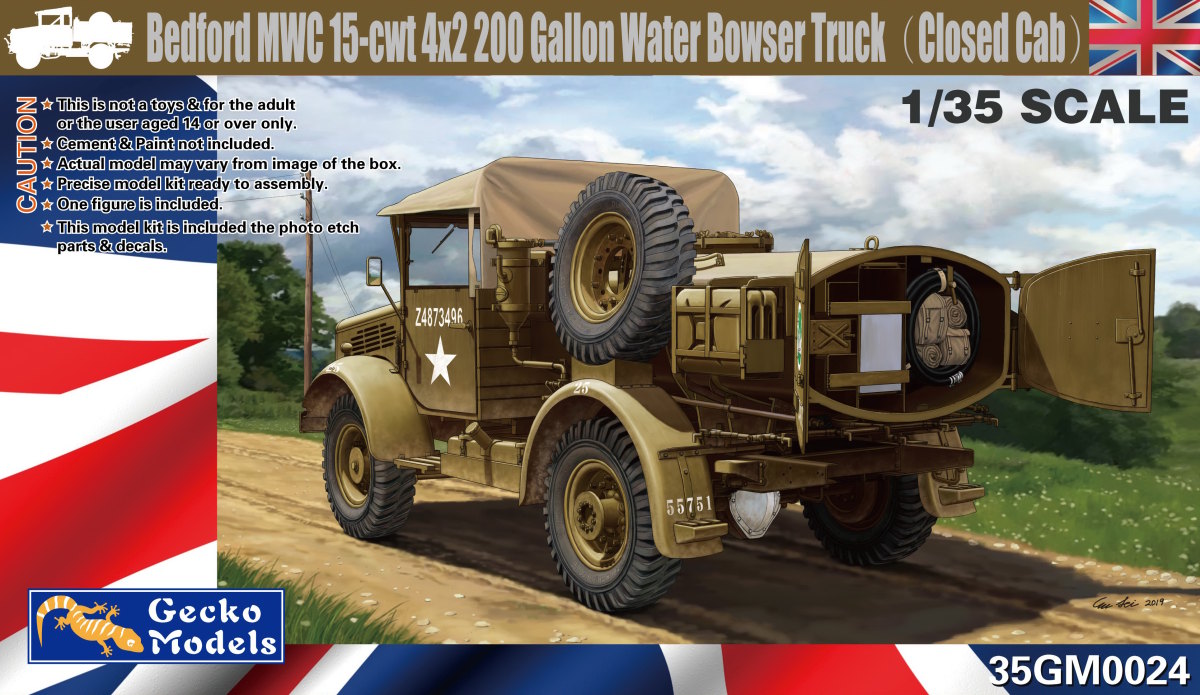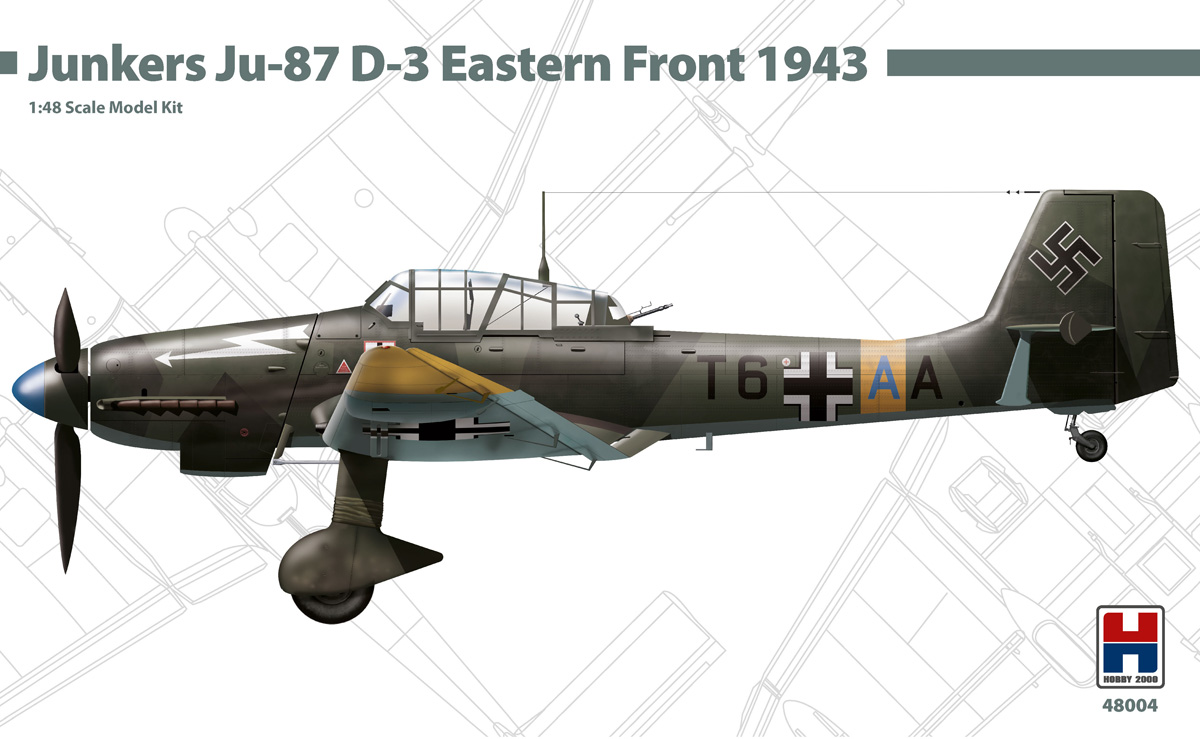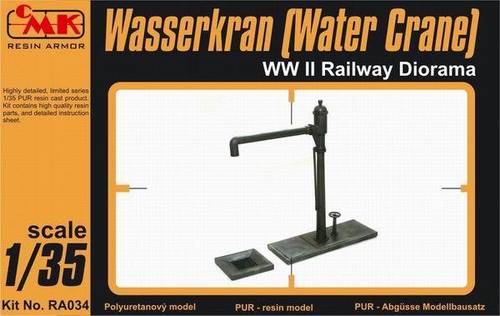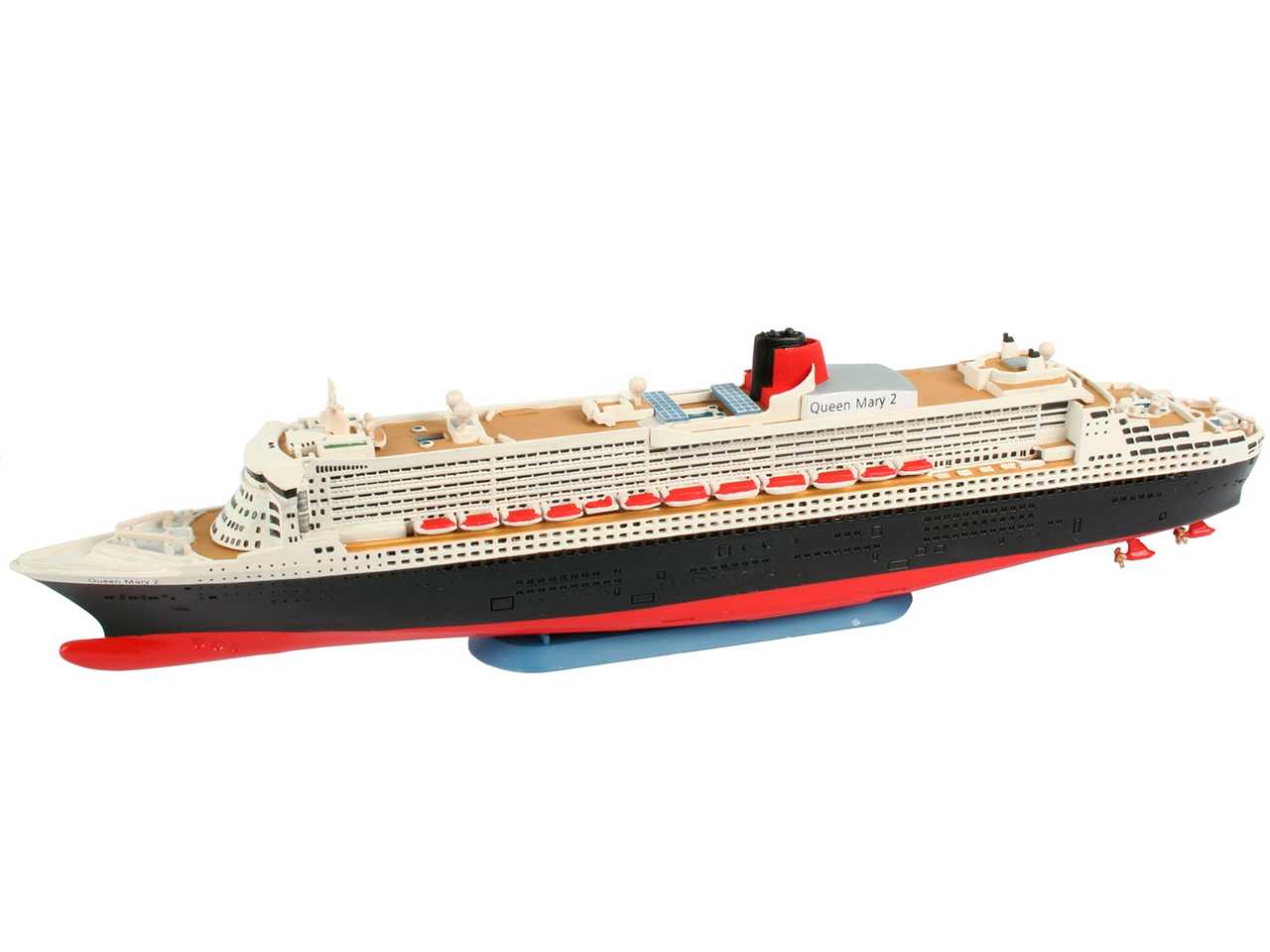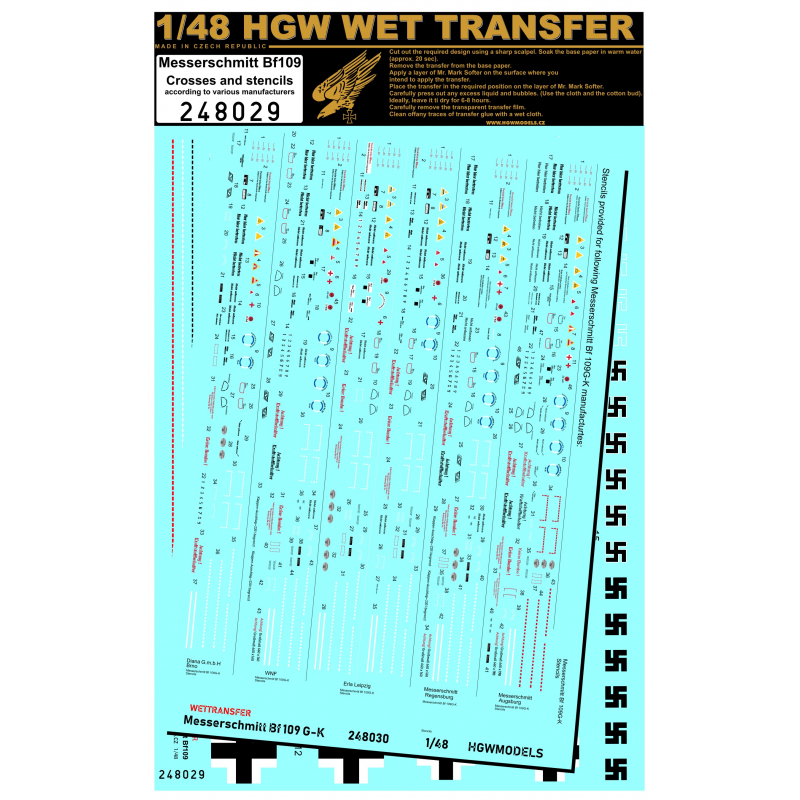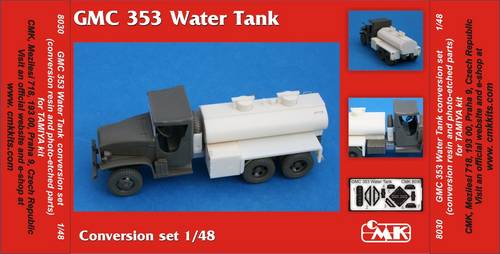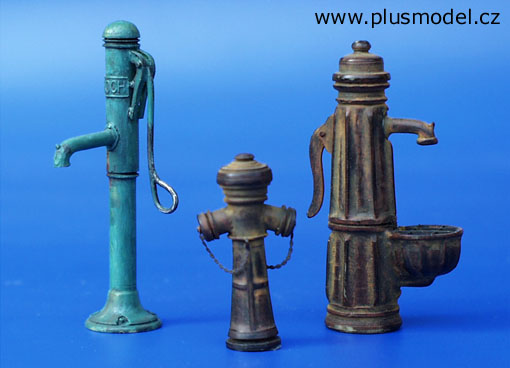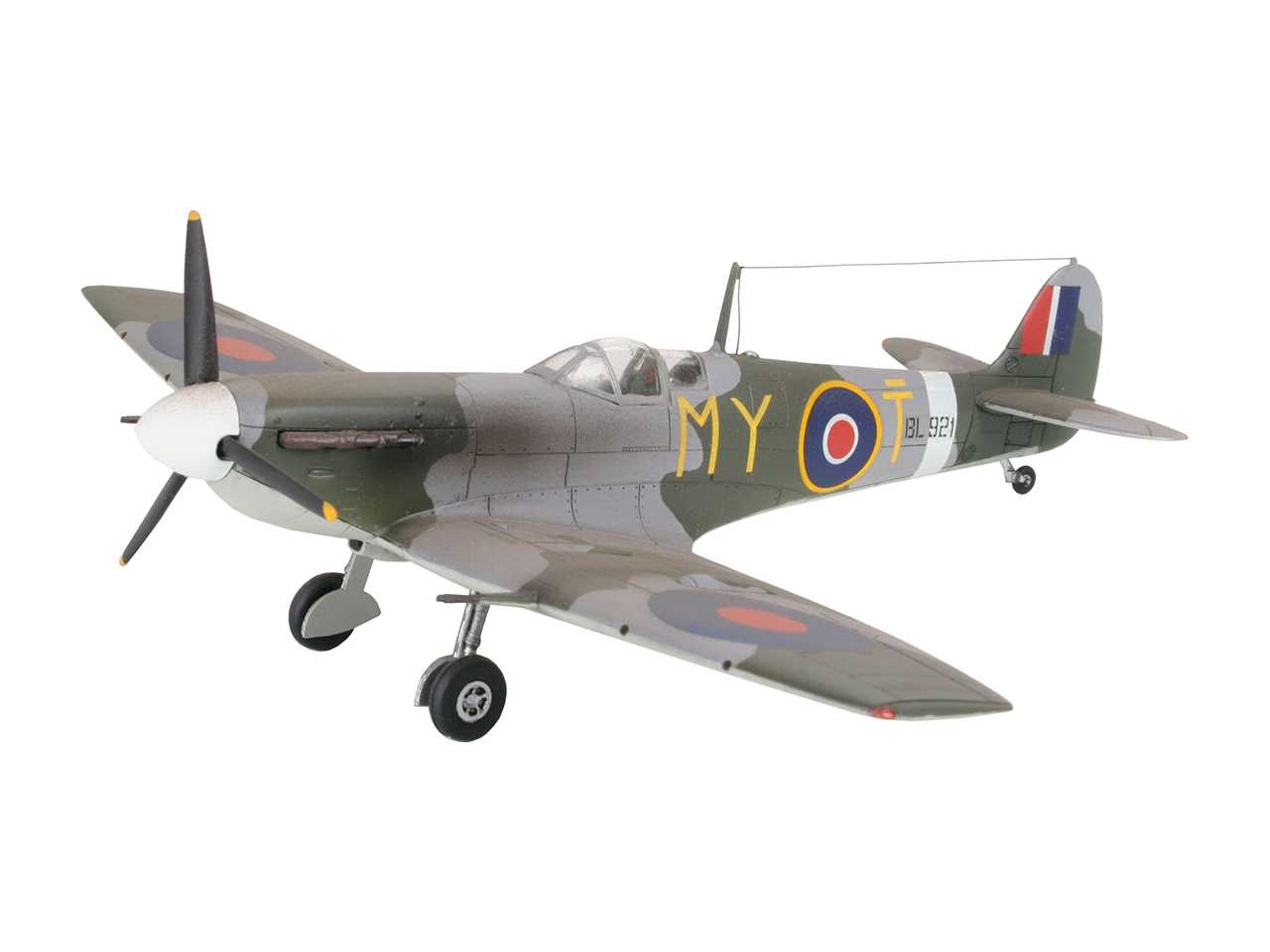Modely
Celkem 201 produktů
1/32 B-25J Mitchell 'Strafer'. North American B-25 Mitchell je americký střední bombardér z období druhé světové války. B-25 byl celokovový jednoplošník s tříbodovým zatahovacím podvozkem a dvojitou směrovou ocasní plochou. Poháněly ho dva motory Wright Cyclon o výkonu od 1300 do 1850 koní v závislosti na verzi. Prototyp byl zalétán v roce 1940 a sériová výroba byla zahájena o rok později. V průběhu války bylo vyrobeno mnoho verzí tohoto bombardéru, mj. B-25G (se 75mm kanónem v přídi), B-25H (se 75mm kanónem a 6 kulomety v přídi) a B-25J (s 8 12,7mm kulomety v přídi). Letouny B-25 bojovaly především v Tichomoří a Středomoří. V určitém počtu byly v rámci dohody o půjčce a pronájmu předány Velké Británii a SSSR, kde si odbyly svůj bojový debut pod Stalingradem. Od roku 1943 létala polská letka č. 305 na B-25. Letoun B-25 se proslavil zejména odvážným bombovým útokem na Tokio v dubnu 1942 (slavný Doolittleův nálet). Technické údaje: Maximální rychlost: 442 km/h, rychlost stoupání: 4 m/s, max. strop: 7600 m, max. dolet: 4300 km, výzbroj: pevná - podle verze 4 až 12 kulometů Browning ráže 12,7 mm nebo kombinace 75mm kanonu a km. podvěsu - až 2700 kg pum. Nesložený a nenabarvený plastikový model. K úspěšnému dokončení této stavebnice je zapotřebí dokoupit barvy, lepidlo na plastikové modely, ředidlo, štětce, které nejsou součástí balení.
1/32 B-25J Mitchell 'Strafer'. North American B-25 Mitchell je americký střední bombardér z období druhé světové války. B-25 byl celokovový jednoplošník s tříbodovým zatahovacím podvozkem a dvojitou směrovou ocasní plochou. Poháněly ho dva motory Wright Cyclon o výkonu od 1300 do 1850 koní v závislosti na verzi. Prototyp byl zalétán v roce 1940 a sériová výroba byla zahájena o rok později. V průběhu války bylo vyrobeno mnoho verzí tohoto bombardéru, mj. B-25G (se 75mm kanónem v přídi), B-25H (se 75mm kanónem a 6 kulomety v přídi) a B-25J (s 8 12,7mm kulomety v přídi). Letouny B-25 bojovaly především v Tichomoří a Středomoří. V určitém počtu byly v rámci dohody o půjčce a pronájmu předány Velké Británii a SSSR, kde si odbyly svůj bojový debut pod Stalingradem. Od roku 1943 létala polská letka č. 305 na B-25. Letoun B-25 se proslavil zejména odvážným bombovým útokem na Tokio v dubnu 1942 (slavný Doolittleův nálet). Technické údaje: Maximální rychlost: 442 km/h, rychlost stoupání: 4 m/s, max. strop: 7600 m, max. dolet: 4300 km, výzbroj: pevná - podle verze 4 až 12 kulometů Browning ráže 12,7 mm nebo kombinace 75mm kanonu a km. podvěsu - až 2700 kg pum. Nesložený a nenabarvený plastikový model. K úspěšnému dokončení této stavebnice je zapotřebí dokoupit barvy, lepidlo na plastikové modely, ředidlo, štětce, které nejsou součástí balení.
1/32 Fokker Dr.I Triplane "Red Baron" includes a 1/10 resin bust. More than one hundred years ago, Europe was in a state of devastation. Farms and pastures were ruined by shell craters and muddy water. Laughter in bars was replaced by people’s sobbing. Bank managers became soldiers hiding in the trenches and primary school teachers plunged bayonets into others’ chests. Everyone on the battlefield was surrounded by the angriest roars and the most vicious curses. But even in the desperate twilight, there was one gem shining brilliantly. Its brightness was so dazzling that it’s still remembered by the once warring parties. Manfred von Richthofen, the cavalry officer who learn to fly in 1915, became the top-scoring ace of World War I by winning 80 air combat victories in less than two years. His iconic red aircraft was well known to both warring parties. The Germans rejoiced in it, and the Allies were convinced by his exquisite combat skills and precious chivalry. As a legend, his death was dramatic because of the bizarre possibilities. The story of the “Red Baron” has gone across time and beyond hatred and is still being told today. The QS-002s Fokker Dr.I Triplane “Red Baron” is a limited edition product based on the MENG QS-002 Fokker Dr.I Triplane kit. This kit includes a 1/10 resin bust of the “Red Baron” Manfred von Richthofen and a Fokker Dr.I Triplane kit. This Manfred von Richthofen bust features calm and confident facial expressions. The figure wears a leather flight jacket over the Imperial German Army uniform. He wears an M1910 Officer Visor Cap on his head and a Blue Max medal on the neckline. This is the most well-known image of the “Red Baron”. This product is limited to 1,000 kits.
1/32 Fokker Dr.I Triplane "Red Baron" includes a 1/10 resin bust. More than one hundred years ago, Europe was in a state of devastation. Farms and pastures were ruined by shell craters and muddy water. Laughter in bars was replaced by people’s sobbing. Bank managers became soldiers hiding in the trenches and primary school teachers plunged bayonets into others’ chests. Everyone on the battlefield was surrounded by the angriest roars and the most vicious curses. But even in the desperate twilight, there was one gem shining brilliantly. Its brightness was so dazzling that it’s still remembered by the once warring parties. Manfred von Richthofen, the cavalry officer who learn to fly in 1915, became the top-scoring ace of World War I by winning 80 air combat victories in less than two years. His iconic red aircraft was well known to both warring parties. The Germans rejoiced in it, and the Allies were convinced by his exquisite combat skills and precious chivalry. As a legend, his death was dramatic because of the bizarre possibilities. The story of the “Red Baron” has gone across time and beyond hatred and is still being told today. The QS-002s Fokker Dr.I Triplane “Red Baron” is a limited edition product based on the MENG QS-002 Fokker Dr.I Triplane kit. This kit includes a 1/10 resin bust of the “Red Baron” Manfred von Richthofen and a Fokker Dr.I Triplane kit. This Manfred von Richthofen bust features calm and confident facial expressions. The figure wears a leather flight jacket over the Imperial German Army uniform. He wears an M1910 Officer Visor Cap on his head and a Blue Max medal on the neckline. This is the most well-known image of the “Red Baron”. This product is limited to 1,000 kits.
1/48 P-61B Nose Art. Northrop P-61 Black Widow, pojmenovaný po severoamerickém pavoukovi, byl prvním operačním americkým válečným letounem určeným pro noční stíhání a prvním letounem, který používal radar. P-61 měl tříčlennou posádku: pilota, střelce a obsluhu radaru. Byl vyzbrojen čtyřmi 20mm (.79 in) kanóny Hispano M2 s přední střelbou umístěnými ve spodní části trupu a čtyřmi kulomety M2 Browning ráže .50 in (12,7 mm) umístěnými v dálkově ovládané hřbetní střelecké věži. Jednalo se o celokovovou dvoumotorovou dvouplošnou konstrukci vyvinutou během druhé světové války. První zkušební let se uskutečnil 26. května 1942, první sériový letoun sjel z montážní linky v říjnu 1943. Poslední letoun byl vyřazen z vládní služby v roce 1954. Přestože se Black Widow nevyráběl ve velkých počtech jako jeho současníci, byl během druhé světové války účinně provozován jako noční stíhač letkami armádního letectva Spojených států v evropském divadle, tichomořském divadle, čínsko-barmském indickém divadle a středomořském divadle. Nahradil dřívější noční stíhací letouny britské konstrukce, které byly modernizovány tak, aby obsahovaly radar, když byl k dispozici. Po válce sloužil P-61 - přeznačený na F-61 - v letectvu Spojených států jako dálkový, denní a noční stíhací letoun pro Velitelství protivzdušné obrany do roku 1948 a pro Pátou leteckou armádu do roku 1950. V noci na 14. srpna 1945 si letoun P-61B 548. noční stíhací perutě s názvem Lady in the Dark neoficiálně připsal poslední spojenecké letecké vítězství před Dnem VJ. P-61 byl také upraven pro vytvoření fotoprůzkumného letounu F-15 Reporter pro armádní letectvo Spojených států a následně používán letectvem Spojených států. Nesložený a nenabarvený plastikový model. K úspěšnému dokončení této stavebnice je zapotřebí dokoupit barvy, lepidlo na plastikové modely, ředidlo, štětce, které nejsou součástí balení.
1/48 P-61B Nose Art. Northrop P-61 Black Widow, pojmenovaný po severoamerickém pavoukovi, byl prvním operačním americkým válečným letounem určeným pro noční stíhání a prvním letounem, který používal radar. P-61 měl tříčlennou posádku: pilota, střelce a obsluhu radaru. Byl vyzbrojen čtyřmi 20mm (.79 in) kanóny Hispano M2 s přední střelbou umístěnými ve spodní části trupu a čtyřmi kulomety M2 Browning ráže .50 in (12,7 mm) umístěnými v dálkově ovládané hřbetní střelecké věži. Jednalo se o celokovovou dvoumotorovou dvouplošnou konstrukci vyvinutou během druhé světové války. První zkušební let se uskutečnil 26. května 1942, první sériový letoun sjel z montážní linky v říjnu 1943. Poslední letoun byl vyřazen z vládní služby v roce 1954. Přestože se Black Widow nevyráběl ve velkých počtech jako jeho současníci, byl během druhé světové války účinně provozován jako noční stíhač letkami armádního letectva Spojených států v evropském divadle, tichomořském divadle, čínsko-barmském indickém divadle a středomořském divadle. Nahradil dřívější noční stíhací letouny britské konstrukce, které byly modernizovány tak, aby obsahovaly radar, když byl k dispozici. Po válce sloužil P-61 - přeznačený na F-61 - v letectvu Spojených států jako dálkový, denní a noční stíhací letoun pro Velitelství protivzdušné obrany do roku 1948 a pro Pátou leteckou armádu do roku 1950. V noci na 14. srpna 1945 si letoun P-61B 548. noční stíhací perutě s názvem Lady in the Dark neoficiálně připsal poslední spojenecké letecké vítězství před Dnem VJ. P-61 byl také upraven pro vytvoření fotoprůzkumného letounu F-15 Reporter pro armádní letectvo Spojených států a následně používán letectvem Spojených států. Nesložený a nenabarvený plastikový model. K úspěšnému dokončení této stavebnice je zapotřebí dokoupit barvy, lepidlo na plastikové modely, ředidlo, štětce, které nejsou součástí balení.
1/32 P-47D Thunderbolt - Super Riveting Set - Riveting Sets - Hasegawa. Package contents:1x P-47D - Riveting Set 1/32 - 3210221x P-47D Thunderbolt - Stencils + Placard - 1/32 - 2320291x P-47D Thunderbolt - Seatbelts 1/32 - 1325321x P-47D Thunderbolt - Masks 1/32 - 632420 Instructions:Convenient undercoat is Mr. Surfacer 1000 or Mr. Base White 1000.*Wipe the surface with a damp cloth, remove dust and grease.Cut the required part from riveting sheet.Remove top translucent paper and dip rivets in the warm water for approx. 15 seconds.When rivets are separated from its carrier paper apply them on the surface. We recommend to use a spot of Mr. Mark Softer.Find appropriate position and then push the liquid from below the transfer. The purpose is to get each rivet in touch with the surface.Let it dry for min. 2 hours, but optimal time could be e.g. over the night.Finally pull of the top transparent foil / film with sharp tweezers and clean the marks caused by transfer glue.* While application on coloured surfaces it is needed to make a test of adhesion and of time which is necessary for appropriate attaching of rivets. Generally the smoother surface the more time needed.
1/32 P-47D Thunderbolt - Super Riveting Set - Riveting Sets - Hasegawa. Package contents:1x P-47D - Riveting Set 1/32 - 3210221x P-47D Thunderbolt - Stencils + Placard - 1/32 - 2320291x P-47D Thunderbolt - Seatbelts 1/32 - 1325321x P-47D Thunderbolt - Masks 1/32 - 632420 Instructions:Convenient undercoat is Mr. Surfacer 1000 or Mr. Base White 1000.*Wipe the surface with a damp cloth, remove dust and grease.Cut the required part from riveting sheet.Remove top translucent paper and dip rivets in the warm water for approx. 15 seconds.When rivets are separated from its carrier paper apply them on the surface. We recommend to use a spot of Mr. Mark Softer.Find appropriate position and then push the liquid from below the transfer. The purpose is to get each rivet in touch with the surface.Let it dry for min. 2 hours, but optimal time could be e.g. over the night.Finally pull of the top transparent foil / film with sharp tweezers and clean the marks caused by transfer glue.* While application on coloured surfaces it is needed to make a test of adhesion and of time which is necessary for appropriate attaching of rivets. Generally the smoother surface the more time needed.
1/72 BHU-6B / UF-2 "Albatross" (Japan Maritime Self-Defense Force). The Beriev Be-8 (USAF/DoD reporting name “Type 33”, NATO reporting name “Mole”), was built by the Soviet Beriev OKB in 1947. It was a passenger/liaison amphibian aircraft with a layout similar to the Be-4 but substantially larger and heavier. It was a single engine parasol with the wing installed on a thin pylon and a pair of short struts. Compared to the Be-4, the Be-8 was equipped with retractable landing gear, and pilot and passenger cabins had heating utilizing engine heat. The Be-8 was intended as a civil aircraft and carried no armament. First flight was on December 3, demonstrating good performance. Two experimental aircraft were built, and one was demonstrated during 1951 Soviet Aviation Day at Tushino.One of Be-8 was equipped with hydrofoils, developed at TsAGI. These “Underwater Wings” were installed on landing gear struts and pushed aircraft above the water well before it could be done by the wing lift force. As a result, takeoff was much easier and imposed less punishment on the hull from the waves. Despite very effective during takeoff hydrofoils had negative impact on flight speed. Construction of retractable hydrofoils was not ready, and the concept did not find practical applications.
1/72 BHU-6B / UF-2 "Albatross" (Japan Maritime Self-Defense Force). The Beriev Be-8 (USAF/DoD reporting name “Type 33”, NATO reporting name “Mole”), was built by the Soviet Beriev OKB in 1947. It was a passenger/liaison amphibian aircraft with a layout similar to the Be-4 but substantially larger and heavier. It was a single engine parasol with the wing installed on a thin pylon and a pair of short struts. Compared to the Be-4, the Be-8 was equipped with retractable landing gear, and pilot and passenger cabins had heating utilizing engine heat. The Be-8 was intended as a civil aircraft and carried no armament. First flight was on December 3, demonstrating good performance. Two experimental aircraft were built, and one was demonstrated during 1951 Soviet Aviation Day at Tushino.One of Be-8 was equipped with hydrofoils, developed at TsAGI. These “Underwater Wings” were installed on landing gear struts and pushed aircraft above the water well before it could be done by the wing lift force. As a result, takeoff was much easier and imposed less punishment on the hull from the waves. Despite very effective during takeoff hydrofoils had negative impact on flight speed. Construction of retractable hydrofoils was not ready, and the concept did not find practical applications.
1/35 EXPERIMENTAL GUN TANK TYPE 5 (HO-RI II). This is an injection-plastic military vehicle model kit. The Experimental Gun Tank Type 5 (Ho-Ri II) was designed but never prototyped. Like the Ho-Ri I, it uses the body of the Type 5 Medium Tank Chi-Ri, and an aircraft gasoline engine (water-cooloed V-type 12-cylinder) was used rather than the traditional diesel engine. The Ho-Ri II also differs from the Ho-Ri 1 in its center-located battle chamber, and its vertical armor. In addition to its other armaments, it carries a pair of 20mm high-firing anti-aircraft cannon at the rear, with a ranging gun on the cupola. Order this tank for your own collection today!
1/72 Be-8 passenger amphibian aircraft. The Beriev Be-8 (USAF/DoD reporting name “Type 33”, NATO reporting name “Mole”), was built by the Soviet Beriev OKB in 1947. It was a passenger/liaison amphibian aircraft with a layout similar to the Be-4 but substantially larger and heavier. It was a single engine parasol with the wing installed on a thin pylon and a pair of short struts. Compared to the Be-4, the Be-8 was equipped with retractable landing gear, and pilot and passenger cabins had heating utilizing engine heat. The Be-8 was intended as a civil aircraft and carried no armament. First flight was on December 3, demonstrating good performance. Two experimental aircraft were built, and one was demonstrated during 1951 Soviet Aviation Day at Tushino.One of Be-8 was equipped with hydrofoils, developed at TsAGI. These “Underwater Wings” were installed on landing gear struts and pushed aircraft above the water well before it could be done by the wing lift force. As a result, takeoff was much easier and imposed less punishment on the hull from the waves. Despite very effective during takeoff hydrofoils had negative impact on flight speed. Construction of retractable hydrofoils was not ready, and the concept did not find practical applications.
1/72 Be-8 passenger amphibian aircraft. The Beriev Be-8 (USAF/DoD reporting name “Type 33”, NATO reporting name “Mole”), was built by the Soviet Beriev OKB in 1947. It was a passenger/liaison amphibian aircraft with a layout similar to the Be-4 but substantially larger and heavier. It was a single engine parasol with the wing installed on a thin pylon and a pair of short struts. Compared to the Be-4, the Be-8 was equipped with retractable landing gear, and pilot and passenger cabins had heating utilizing engine heat. The Be-8 was intended as a civil aircraft and carried no armament. First flight was on December 3, demonstrating good performance. Two experimental aircraft were built, and one was demonstrated during 1951 Soviet Aviation Day at Tushino.One of Be-8 was equipped with hydrofoils, developed at TsAGI. These “Underwater Wings” were installed on landing gear struts and pushed aircraft above the water well before it could be done by the wing lift force. As a result, takeoff was much easier and imposed less punishment on the hull from the waves. Despite very effective during takeoff hydrofoils had negative impact on flight speed. Construction of retractable hydrofoils was not ready, and the concept did not find practical applications.
1/72 Be-8 amphibian aircraft (with water skis & hydrofoils). The Beriev Be-8 (USAF/DoD reporting name “Type 33”, NATO reporting name “Mole”), was built by the Soviet Beriev OKB in 1947. It was a passenger/liaison amphibian aircraft with a layout similar to the Be-4 but substantially larger and heavier. It was a single engine parasol with the wing installed on a thin pylon and a pair of short struts. Compared to the Be-4, the Be-8 was equipped with retractable landing gear, and pilot and passenger cabins had heating utilizing engine heat. The Be-8 was intended as a civil aircraft and carried no armament. First flight was on December 3, demonstrating good performance. Two experimental aircraft were built, and one was demonstrated during 1951 Soviet Aviation Day at Tushino.One of Be-8 was equipped with hydrofoils, developed at TsAGI. These “Underwater Wings” were installed on landing gear struts and pushed aircraft above the water well before it could be done by the wing lift force. As a result, takeoff was much easier and imposed less punishment on the hull from the waves. Despite very effective during takeoff hydrofoils had negative impact on flight speed. Construction of retractable hydrofoils was not ready, and the concept did not find practical applications.
1/35 EXPERIMENTAL GUN TANK TYPE 5 (HO-RI II). This is an injection-plastic military vehicle model kit. The Experimental Gun Tank Type 5 (Ho-Ri II) was designed but never prototyped. Like the Ho-Ri I, it uses the body of the Type 5 Medium Tank Chi-Ri, and an aircraft gasoline engine (water-cooloed V-type 12-cylinder) was used rather than the traditional diesel engine. The Ho-Ri II also differs from the Ho-Ri 1 in its center-located battle chamber, and its vertical armor. In addition to its other armaments, it carries a pair of 20mm high-firing anti-aircraft cannon at the rear, with a ranging gun on the cupola. Order this tank for your own collection today!
1/72 Be-8 amphibian aircraft (with water skis & hydrofoils). The Beriev Be-8 (USAF/DoD reporting name “Type 33”, NATO reporting name “Mole”), was built by the Soviet Beriev OKB in 1947. It was a passenger/liaison amphibian aircraft with a layout similar to the Be-4 but substantially larger and heavier. It was a single engine parasol with the wing installed on a thin pylon and a pair of short struts. Compared to the Be-4, the Be-8 was equipped with retractable landing gear, and pilot and passenger cabins had heating utilizing engine heat. The Be-8 was intended as a civil aircraft and carried no armament. First flight was on December 3, demonstrating good performance. Two experimental aircraft were built, and one was demonstrated during 1951 Soviet Aviation Day at Tushino.One of Be-8 was equipped with hydrofoils, developed at TsAGI. These “Underwater Wings” were installed on landing gear struts and pushed aircraft above the water well before it could be done by the wing lift force. As a result, takeoff was much easier and imposed less punishment on the hull from the waves. Despite very effective during takeoff hydrofoils had negative impact on flight speed. Construction of retractable hydrofoils was not ready, and the concept did not find practical applications.
1/35 Bedford MWC 15-cwt 4x2 200 Gallon Water Bowser Truck (Closed Cab). Gecko Models brings us a kit of the Closed Cab Bedford MWC. The Bedford MW was developed by Vauxhall in 1935 and produced in 1939 before World War II, and its intended use was mainly for the British Army Infantry battalions. Later developed to take on a number of roles and to be later utilized by different forces (such as the Royal Air Force, the Royal Navy, and others), this kit lets you replicate the Bedford MWC 15-cwt 4x2 200 Gallon Water Bowser Truck variation. When fully assembled this model features a front window, a half cabin door, and a water tank with an oval shaped cross section. [Includes]: Photo-etched parts, decal sheet x1, figure x1
1/35 Bedford MWC 15-cwt 4x2 200 Gallon Water Bowser Truck (Closed Cab). Gecko Models brings us a kit of the Closed Cab Bedford MWC. The Bedford MW was developed by Vauxhall in 1935 and produced in 1939 before World War II, and its intended use was mainly for the British Army Infantry battalions. Later developed to take on a number of roles and to be later utilized by different forces (such as the Royal Air Force, the Royal Navy, and others), this kit lets you replicate the Bedford MWC 15-cwt 4x2 200 Gallon Water Bowser Truck variation. When fully assembled this model features a front window, a half cabin door, and a water tank with an oval shaped cross section. [Includes]: Photo-etched parts, decal sheet x1, figure x1
1/35 Russian armored vehicle Typhoon-K 6X6 - Zvezda. Model military ke slepení. Velikost: 1:35; 22,7 cm. Počet dílků: 372. Informace o originálu a modelu: Typhoon-K je ruské obrněnné vozidlo MRAP (chráněné a odolné proti útoku) s pohonem 6 x 6 off-road, určené pro bezpečnou přepravu vojenského personálu a nákladu. Může vézt 10 - 16 vojáků, kteří mohou vozidlo opustit buď rampou nebo dveřmi, únikové poklopy jsou v případě nouze také na střeše. Kabina je z neprůstřelného pancíře, který poskytuje ochranu proti 30mm nábojům. Vozidlo je ve výrobě od roku 2015, má hydropneumatické, nezávislé zavěšení, automatickou převodovku a je poháněno dieselovým motorem o výkonu 450 hp. Může dosáhnout rychlosti až 80 km/h, max. dojezd je 1200 km. Typhoon-K využívá ruská vojenská police během operací v Sýrii. Barevné schéma (Doporučené barvy Zvezda): - 08, 10, 12, 20, 30, 31, 45, 55 Detaily modelu: Měřítko: 1:35 Délka: 227 mm Počet dílků: 372 Doporučeno pro děti od 14 let. Upozornění: Nebezpečí udušení! Výrobek obsahuje malé části. NEVHODNÉ PRO DĚTI DO 3 LET!
1/35 Russian armored vehicle Typhoon-K 6X6 - Zvezda. Model military ke slepení. Velikost: 1:35; 22,7 cm. Počet dílků: 372. Informace o originálu a modelu: Typhoon-K je ruské obrněnné vozidlo MRAP (chráněné a odolné proti útoku) s pohonem 6 x 6 off-road, určené pro bezpečnou přepravu vojenského personálu a nákladu. Může vézt 10 - 16 vojáků, kteří mohou vozidlo opustit buď rampou nebo dveřmi, únikové poklopy jsou v případě nouze také na střeše. Kabina je z neprůstřelného pancíře, který poskytuje ochranu proti 30mm nábojům. Vozidlo je ve výrobě od roku 2015, má hydropneumatické, nezávislé zavěšení, automatickou převodovku a je poháněno dieselovým motorem o výkonu 450 hp. Může dosáhnout rychlosti až 80 km/h, max. dojezd je 1200 km. Typhoon-K využívá ruská vojenská police během operací v Sýrii. Barevné schéma (Doporučené barvy Zvezda): - 08, 10, 12, 20, 30, 31, 45, 55 Detaily modelu: Měřítko: 1:35 Délka: 227 mm Počet dílků: 372 Doporučeno pro děti od 14 let. Upozornění: Nebezpečí udušení! Výrobek obsahuje malé části. NEVHODNÉ PRO DĚTI DO 3 LET!
1/72 KDA-2 type 88-2 scout. The Beriev Be-8 (USAF/DoD reporting name “Type 33”, NATO reporting name “Mole”), was built by the Soviet Beriev OKB in 1947. It was a passenger/liaison amphibian aircraft with a layout similar to the Be-4 but substantially larger and heavier. It was a single engine parasol with the wing installed on a thin pylon and a pair of short struts. Compared to the Be-4, the Be-8 was equipped with retractable landing gear, and pilot and passenger cabins had heating utilizing engine heat. The Be-8 was intended as a civil aircraft and carried no armament. First flight was on December 3, demonstrating good performance. Two experimental aircraft were built, and one was demonstrated during 1951 Soviet Aviation Day at Tushino.One of Be-8 was equipped with hydrofoils, developed at TsAGI. These “Underwater Wings” were installed on landing gear struts and pushed aircraft above the water well before it could be done by the wing lift force. As a result, takeoff was much easier and imposed less punishment on the hull from the waves. Despite very effective during takeoff hydrofoils had negative impact on flight speed. Construction of retractable hydrofoils was not ready, and the concept did not find practical applications.
1/72 KDA-2 type 88 light bomber. The Beriev Be-8 (USAF/DoD reporting name “Type 33”, NATO reporting name “Mole”), was built by the Soviet Beriev OKB in 1947. It was a passenger/liaison amphibian aircraft with a layout similar to the Be-4 but substantially larger and heavier. It was a single engine parasol with the wing installed on a thin pylon and a pair of short struts. Compared to the Be-4, the Be-8 was equipped with retractable landing gear, and pilot and passenger cabins had heating utilizing engine heat. The Be-8 was intended as a civil aircraft and carried no armament. First flight was on December 3, demonstrating good performance. Two experimental aircraft were built, and one was demonstrated during 1951 Soviet Aviation Day at Tushino.One of Be-8 was equipped with hydrofoils, developed at TsAGI. These “Underwater Wings” were installed on landing gear struts and pushed aircraft above the water well before it could be done by the wing lift force. As a result, takeoff was much easier and imposed less punishment on the hull from the waves. Despite very effective during takeoff hydrofoils had negative impact on flight speed. Construction of retractable hydrofoils was not ready, and the concept did not find practical applications.
1/72 KDA-2 type 88-1 scout. The Beriev Be-8 (USAF/DoD reporting name “Type 33”, NATO reporting name “Mole”), was built by the Soviet Beriev OKB in 1947. It was a passenger/liaison amphibian aircraft with a layout similar to the Be-4 but substantially larger and heavier. It was a single engine parasol with the wing installed on a thin pylon and a pair of short struts. Compared to the Be-4, the Be-8 was equipped with retractable landing gear, and pilot and passenger cabins had heating utilizing engine heat. The Be-8 was intended as a civil aircraft and carried no armament. First flight was on December 3, demonstrating good performance. Two experimental aircraft were built, and one was demonstrated during 1951 Soviet Aviation Day at Tushino.One of Be-8 was equipped with hydrofoils, developed at TsAGI. These “Underwater Wings” were installed on landing gear struts and pushed aircraft above the water well before it could be done by the wing lift force. As a result, takeoff was much easier and imposed less punishment on the hull from the waves. Despite very effective during takeoff hydrofoils had negative impact on flight speed. Construction of retractable hydrofoils was not ready, and the concept did not find practical applications.
1/72 KDA-2 type 88 light bomber. The Beriev Be-8 (USAF/DoD reporting name “Type 33”, NATO reporting name “Mole”), was built by the Soviet Beriev OKB in 1947. It was a passenger/liaison amphibian aircraft with a layout similar to the Be-4 but substantially larger and heavier. It was a single engine parasol with the wing installed on a thin pylon and a pair of short struts. Compared to the Be-4, the Be-8 was equipped with retractable landing gear, and pilot and passenger cabins had heating utilizing engine heat. The Be-8 was intended as a civil aircraft and carried no armament. First flight was on December 3, demonstrating good performance. Two experimental aircraft were built, and one was demonstrated during 1951 Soviet Aviation Day at Tushino.One of Be-8 was equipped with hydrofoils, developed at TsAGI. These “Underwater Wings” were installed on landing gear struts and pushed aircraft above the water well before it could be done by the wing lift force. As a result, takeoff was much easier and imposed less punishment on the hull from the waves. Despite very effective during takeoff hydrofoils had negative impact on flight speed. Construction of retractable hydrofoils was not ready, and the concept did not find practical applications.
1/72 KDA-2 type 88-1 scout. The Beriev Be-8 (USAF/DoD reporting name “Type 33”, NATO reporting name “Mole”), was built by the Soviet Beriev OKB in 1947. It was a passenger/liaison amphibian aircraft with a layout similar to the Be-4 but substantially larger and heavier. It was a single engine parasol with the wing installed on a thin pylon and a pair of short struts. Compared to the Be-4, the Be-8 was equipped with retractable landing gear, and pilot and passenger cabins had heating utilizing engine heat. The Be-8 was intended as a civil aircraft and carried no armament. First flight was on December 3, demonstrating good performance. Two experimental aircraft were built, and one was demonstrated during 1951 Soviet Aviation Day at Tushino.One of Be-8 was equipped with hydrofoils, developed at TsAGI. These “Underwater Wings” were installed on landing gear struts and pushed aircraft above the water well before it could be done by the wing lift force. As a result, takeoff was much easier and imposed less punishment on the hull from the waves. Despite very effective during takeoff hydrofoils had negative impact on flight speed. Construction of retractable hydrofoils was not ready, and the concept did not find practical applications.
1/72 KDA-2 type 88-2 scout. The Beriev Be-8 (USAF/DoD reporting name “Type 33”, NATO reporting name “Mole”), was built by the Soviet Beriev OKB in 1947. It was a passenger/liaison amphibian aircraft with a layout similar to the Be-4 but substantially larger and heavier. It was a single engine parasol with the wing installed on a thin pylon and a pair of short struts. Compared to the Be-4, the Be-8 was equipped with retractable landing gear, and pilot and passenger cabins had heating utilizing engine heat. The Be-8 was intended as a civil aircraft and carried no armament. First flight was on December 3, demonstrating good performance. Two experimental aircraft were built, and one was demonstrated during 1951 Soviet Aviation Day at Tushino.One of Be-8 was equipped with hydrofoils, developed at TsAGI. These “Underwater Wings” were installed on landing gear struts and pushed aircraft above the water well before it could be done by the wing lift force. As a result, takeoff was much easier and imposed less punishment on the hull from the waves. Despite very effective during takeoff hydrofoils had negative impact on flight speed. Construction of retractable hydrofoils was not ready, and the concept did not find practical applications.
1/48 Junkers Ju-87 D-3 Eastern Front 1943 ( HASEGAWA + Cartograf ). Plastikový model německého střemhlavého bombardéru Junkers Ju-87 D-3, ex Hasegawa v měřítku 1/48, obtisky Cartograf. Dvě obtiskové varianty Ju 87 D-3, T6 + AA, St.G. 2 Kommodore Obst. Dr. Ernst Kupfer, Bagerovo, oblast Kuban, srpen 1943 Ju 87 D-3, "bílý 10", uprav. Av. Ovidiu Cerecel, Esc. 73, Grupul 3, Rusko, srpen 1943 Nutno dokoupit: barvy, lepidlo na plastikové modely, ředidlo, štětce.
1/48 Junkers Ju-87 D-3 Eastern Front 1943 ( HASEGAWA + Cartograf ). Plastikový model německého střemhlavého bombardéru Junkers Ju-87 D-3, ex Hasegawa v měřítku 1/48, obtisky Cartograf. Dvě obtiskové varianty Ju 87 D-3, T6 + AA, St.G. 2 Kommodore Obst. Dr. Ernst Kupfer, Bagerovo, oblast Kuban, srpen 1943 Ju 87 D-3, "bílý 10", uprav. Av. Ovidiu Cerecel, Esc. 73, Grupul 3, Rusko, srpen 1943 Nutno dokoupit: barvy, lepidlo na plastikové modely, ředidlo, štětce.
ModelSet loď 65808 - QUEEN MARY 2 (1:1200). Model lodi ke slepení. Velikost: 1:1200; 28,7 cm. Balení obsahuje: 45 dílků ke slepení, lepidlo, štětec, barvičky 301, 302, 88 (5 ml). Informace o originálu: Queen Mary 2 je vynikající osobní parník. Se 150,000 GRT je to největší, nejdelší (345 m), nejvyšší (o 72 m vyšší než Socha svobody) a nejvelkolepější loď, který kdy byla pro Cunard Line postavena. 2, 620 pasažérů může být ubytováno ve čtrnácti stylových a luxusně vybavených palubách spolu s posádkou 1, 253 lidí. Se svým dlouhým, elegantním trupem a výkonnými motory (max. 29 uzlů) byla speciálně navržená na zámořské cesty; z Evropy (Southampton, Anglie) do Severní Ameriky (New York) za šest dní. Koncept Queen Mary 2 byl vytvořen v květnu 1998. Po dalších dvou letech vývoje, v listopadu 2000, byla obědnána franzouzskou loděnicí a byla předána Cunard Line 22. prosince 2003. Po přezimování v Karibiku loď v dubnu 2004 vstoupila do pravidelné transatlantické služby. Queen Mary 2 pokračovala v tradici severoatlantských cest, a tak pokračovala éra oceánského cestování , která již byla považována za skončenou. Informace o modelu: - Detailní trup s mnoha strukturami - 4 motorové podvěsy s hnacími šrouby - Strukturální detaily na hlavní palubě - Detailní bazény s volitelným obtiskem - Detailní palubní nástavby - Detailní komín - Anténní kopule - 8 člunů, 14 záchranných člunů a 2 malé rychlé čluny - Přední paluba se dvěma nákladními jeřáby - Reprodukce tenisových kurtů - Stojan s nálepkami Potřebné barvy: - základní: 37, 88, 301, 302 - další: 30, 34, 90, 91, 371 Detaily modelu Měřítko: 1:1200 Počet dílů: 45 Délka: 287 mm Obtížnost: 3 Detaily originálu: Typ: Zaoceánský parník Rok/období: 2003 Původ: Velká Británie Kapacita motoru: 115.390 kW Rychlost: 30 uzlů Doporučeno pro děti od 10 let. Pozor! Nevhodné pro děti do 8 let. Děti mohou výrobek používat pouze pod dohledem dospělé osoby. Akrylová barva pro modeláře Revell Aqua Color (5 ml) Návod na použití: Vodou ředitelná akrylová barva. Před použitím barvu dobře promíchejte. Nanášejte štětcem, nebo stříkáním na suchý, čistý povrch. Nehořlavá báze, rychle zasychá – nebarvitelné po 1 hodině, úplně uschne za 2–3 hodiny, podle tloušťky vrstvy. V případě potřeby zřeďte vodou. Použitím nevhodného ředidla se může barva zničit! Čistí se ředidlem Revell Aqua Color Clean. Na stříkání se doporučuje ředění maximálně 20 - 25 %. Štětec a pomůcky ihned po použití vypláchněte vodou. Nádobku po použití pevně uzavřete. Po otevření spotřebujte co nejdříve, barva přístupem vzduchu zasychá. Chraňte před mrazem. Obsahuje Směs látek 5-chlor-2methylisothiazol-3(2H)on a 2-methylizothiazol3(2H)-on s chloridem hořečnatým a dusičnanem hořečnatým. Může vyvolat alergickou reakci. Upozornění: Uchovávejte mimo dosah dětí. Zneškodněte tento materiál a jeho obal ve sběrném místě pro zvláštní nebo nebezpečné odpady. Pozor! Nevhodné pro děti do 8 let. Děti mohou výrobek používat pouze pod dohledem dospělé osoby. Tekuté lepidlo na plasty Revell Contacta Professional Návod na použití: Vhodné na přesné lepení sestavovaných modelů. Balení s jehlovým aplikátorem. Lepidlo naneste na jednu plochu. Lepené plochy k sobě přitlačte mírným tlakem. Spoj schne 5-10 sekund, dokonale vytvrdne do 1 hodiny. Přečtěte a uschovejte. Varování! Obsahuje: n-Butylacetat. Hořlavá kapalina a páry. Může způsobit ospalost nebo závratě. Je-li nutná lékařská pomoc, mějte po ruce obal nebo štítek výrobku. Uchovávejte mimo dosah dětí. Před použitím si přečtěte údaje na štítku. Chraňte před teplem/jiskrami/otevřeným plamenem/horkými povrchy. Zákaz kouření.Tento výrobek není hračka!
ModelSet loď 65808 - QUEEN MARY 2 (1:1200). Model lodi ke slepení. Velikost: 1:1200; 28,7 cm. Balení obsahuje: 45 dílků ke slepení, lepidlo, štětec, barvičky 301, 302, 88 (5 ml). Informace o originálu: Queen Mary 2 je vynikající osobní parník. Se 150,000 GRT je to největší, nejdelší (345 m), nejvyšší (o 72 m vyšší než Socha svobody) a nejvelkolepější loď, který kdy byla pro Cunard Line postavena. 2, 620 pasažérů může být ubytováno ve čtrnácti stylových a luxusně vybavených palubách spolu s posádkou 1, 253 lidí. Se svým dlouhým, elegantním trupem a výkonnými motory (max. 29 uzlů) byla speciálně navržená na zámořské cesty; z Evropy (Southampton, Anglie) do Severní Ameriky (New York) za šest dní. Koncept Queen Mary 2 byl vytvořen v květnu 1998. Po dalších dvou letech vývoje, v listopadu 2000, byla obědnána franzouzskou loděnicí a byla předána Cunard Line 22. prosince 2003. Po přezimování v Karibiku loď v dubnu 2004 vstoupila do pravidelné transatlantické služby. Queen Mary 2 pokračovala v tradici severoatlantských cest, a tak pokračovala éra oceánského cestování , která již byla považována za skončenou. Informace o modelu: - Detailní trup s mnoha strukturami - 4 motorové podvěsy s hnacími šrouby - Strukturální detaily na hlavní palubě - Detailní bazény s volitelným obtiskem - Detailní palubní nástavby - Detailní komín - Anténní kopule - 8 člunů, 14 záchranných člunů a 2 malé rychlé čluny - Přední paluba se dvěma nákladními jeřáby - Reprodukce tenisových kurtů - Stojan s nálepkami Potřebné barvy: - základní: 37, 88, 301, 302 - další: 30, 34, 90, 91, 371 Detaily modelu Měřítko: 1:1200 Počet dílů: 45 Délka: 287 mm Obtížnost: 3 Detaily originálu: Typ: Zaoceánský parník Rok/období: 2003 Původ: Velká Británie Kapacita motoru: 115.390 kW Rychlost: 30 uzlů Doporučeno pro děti od 10 let. Pozor! Nevhodné pro děti do 8 let. Děti mohou výrobek používat pouze pod dohledem dospělé osoby. Akrylová barva pro modeláře Revell Aqua Color (5 ml) Návod na použití: Vodou ředitelná akrylová barva. Před použitím barvu dobře promíchejte. Nanášejte štětcem, nebo stříkáním na suchý, čistý povrch. Nehořlavá báze, rychle zasychá – nebarvitelné po 1 hodině, úplně uschne za 2–3 hodiny, podle tloušťky vrstvy. V případě potřeby zřeďte vodou. Použitím nevhodného ředidla se může barva zničit! Čistí se ředidlem Revell Aqua Color Clean. Na stříkání se doporučuje ředění maximálně 20 - 25 %. Štětec a pomůcky ihned po použití vypláchněte vodou. Nádobku po použití pevně uzavřete. Po otevření spotřebujte co nejdříve, barva přístupem vzduchu zasychá. Chraňte před mrazem. Obsahuje Směs látek 5-chlor-2methylisothiazol-3(2H)on a 2-methylizothiazol3(2H)-on s chloridem hořečnatým a dusičnanem hořečnatým. Může vyvolat alergickou reakci. Upozornění: Uchovávejte mimo dosah dětí. Zneškodněte tento materiál a jeho obal ve sběrném místě pro zvláštní nebo nebezpečné odpady. Pozor! Nevhodné pro děti do 8 let. Děti mohou výrobek používat pouze pod dohledem dospělé osoby. Tekuté lepidlo na plasty Revell Contacta Professional Návod na použití: Vhodné na přesné lepení sestavovaných modelů. Balení s jehlovým aplikátorem. Lepidlo naneste na jednu plochu. Lepené plochy k sobě přitlačte mírným tlakem. Spoj schne 5-10 sekund, dokonale vytvrdne do 1 hodiny. Přečtěte a uschovejte. Varování! Obsahuje: n-Butylacetat. Hořlavá kapalina a páry. Může způsobit ospalost nebo závratě. Je-li nutná lékařská pomoc, mějte po ruce obal nebo štítek výrobku. Uchovávejte mimo dosah dětí. Před použitím si přečtěte údaje na štítku. Chraňte před teplem/jiskrami/otevřeným plamenem/horkými povrchy. Zákaz kouření.Tento výrobek není hračka!
Model Kit letadlo 7026 - Boeing 737- 8 MAX (1:144). Model letadla ke slepení. Velikost: 1:144; 27,4 cm. Počet dílků: 121. Informace o modelu: Doporučené barvy (Zvezda): Detaily modelu: Měřítko: 1:144 Délka: 274 mm Počet dílků: 121 Doporučeno pro děti od 10 let. Upozornění: Nebezpečí udušení! Výrobek obsahuje malé části. NEVHODNÉ PRO DĚTI DO 3 LET!
Model Kit letadlo 7026 - Boeing 737- 8 MAX (1:144). Model letadla ke slepení. Velikost: 1:144; 27,4 cm. Počet dílků: 121. Informace o modelu: Doporučené barvy (Zvezda): Detaily modelu: Měřítko: 1:144 Délka: 274 mm Počet dílků: 121 Doporučeno pro děti od 10 let. Upozornění: Nebezpečí udušení! Výrobek obsahuje malé části. NEVHODNÉ PRO DĚTI DO 3 LET!
1/48 Messerschmitt Bf109 Crosses + Stencils - Wet Transfers - various manufacturers. Crosses and stencils for Messerschmitt Bf109 in 1/48 scale. Wet transfer technology means that decal doesn't leave any signs of varnish or typical film after its application, so only text or symbols stay attached to the surface. The biggest issue relating to using ordinary decals is the varnish which creates a glossy film around the decal. It is quite hard to work with classic decals the way to make this film invisible and it is impossible to reach a good result in case of metallic surfaces. OK, there are dry transfers on the market but work with them is also quite uncomfortable, it is hard to place them correctly and a modeler has the one chance only. HGW's wet transfers are similar to ordinary decals. It is possible to move them during the attaching process and find the best position. Then just push the water from below the transfer, let it dry few hours, remove the transfer foil and work is done. Only text or symbol stays attached to the surface. Instructions: 1. Cut the required part.2. Soak in hot water and wait till the decal loose its base-paper.3. Apply as regular decal.4. Push the water from below the decal.5. Let it dry for 2-3 hours.6. Remove the transfer foil and clean the glue stains with water.
1/48 Messerschmitt Bf109 Crosses + Stencils - Wet Transfers - various manufacturers. Crosses and stencils for Messerschmitt Bf109 in 1/48 scale. Wet transfer technology means that decal doesn't leave any signs of varnish or typical film after its application, so only text or symbols stay attached to the surface. The biggest issue relating to using ordinary decals is the varnish which creates a glossy film around the decal. It is quite hard to work with classic decals the way to make this film invisible and it is impossible to reach a good result in case of metallic surfaces. OK, there are dry transfers on the market but work with them is also quite uncomfortable, it is hard to place them correctly and a modeler has the one chance only. HGW's wet transfers are similar to ordinary decals. It is possible to move them during the attaching process and find the best position. Then just push the water from below the transfer, let it dry few hours, remove the transfer foil and work is done. Only text or symbol stays attached to the surface. Instructions: 1. Cut the required part.2. Soak in hot water and wait till the decal loose its base-paper.3. Apply as regular decal.4. Push the water from below the decal.5. Let it dry for 2-3 hours.6. Remove the transfer foil and clean the glue stains with water.
Plastic ModelKit letadlo 04744 - Fokker Dr.I 'Richthofen' (1:28). Model letadla ke slepení. Velikost: 1:28; 21,1 cm. Balení obsahuje: 66 dílků ke slepení. Manfred von Richthofen, „Rudý baron“ a jeho rudý Fokker trojplošník vytvářeli historii První světové války. Byl představen západní frontě v červnu 1917 poté, co Generální štáb schválil Fokker Dr. I po rozsáhlých testech a pokračovali schválením leteckého esa Manfreda von Richthofena.Dr. I byl nejobratnější ze všech letounů a dosahoval vysokých rychlostí. Hvězdicový motor Oberursel (výkon 110 koní) dodával Dr.I maximální rychlost 193 km/h a umožňuje mu vzlétnou do 3000 m za šest minut. Dvě Snandau Mg byly instalovány vepředu v kabině. Všichni piloti v Richthofenově skupině řídili rudé trojplošníky. Přestože byl Dr. I koncipován západní frontou na konci roku 1917, pokračoval Rudý baron v řízení tohoto typu aby sestřelil celem 80 nepřátelských letounů předtím, než byl sám sestřelen v dubnu roku 1918. Detaily modelu: - Detailní hvězdicový motor - Pohyblivá vrtule - Detailní kabina s řídící pákou, sedadlem a pedály - Strukturálně detailní křídla - Dvě Spandau MG - Podvozek s pohyblivými koly - Figurka pilota von Richthofena a dvě figurky pozemní posádky - Obtisky s národní vlajkou a značkami - Nit není součástí Barvy: - základní: 05, 35, 36, 79, 87, 88 - další: 08, 09, 45, 46, 55, 68, 90, 93, 382 Detaily modelu: Měřítko: 1:28 Počet dílů: 66 Délka: 211 mm Rozpětí křídel: 262 mm Obtížnost: 3 Detaily originálu: Typ: trojplošník Rok/období: 1917 Původ: Německo Kapacita motoru: 81 kW Rychlost: 193 km/h Doporučeno pro děti od 10 let.
Plastic ModelKit letadlo 04744 - Fokker Dr.I 'Richthofen' (1:28). Model letadla ke slepení. Velikost: 1:28; 21,1 cm. Balení obsahuje: 66 dílků ke slepení. Manfred von Richthofen, „Rudý baron“ a jeho rudý Fokker trojplošník vytvářeli historii První světové války. Byl představen západní frontě v červnu 1917 poté, co Generální štáb schválil Fokker Dr. I po rozsáhlých testech a pokračovali schválením leteckého esa Manfreda von Richthofena.Dr. I byl nejobratnější ze všech letounů a dosahoval vysokých rychlostí. Hvězdicový motor Oberursel (výkon 110 koní) dodával Dr.I maximální rychlost 193 km/h a umožňuje mu vzlétnou do 3000 m za šest minut. Dvě Snandau Mg byly instalovány vepředu v kabině. Všichni piloti v Richthofenově skupině řídili rudé trojplošníky. Přestože byl Dr. I koncipován západní frontou na konci roku 1917, pokračoval Rudý baron v řízení tohoto typu aby sestřelil celem 80 nepřátelských letounů předtím, než byl sám sestřelen v dubnu roku 1918. Detaily modelu: - Detailní hvězdicový motor - Pohyblivá vrtule - Detailní kabina s řídící pákou, sedadlem a pedály - Strukturálně detailní křídla - Dvě Spandau MG - Podvozek s pohyblivými koly - Figurka pilota von Richthofena a dvě figurky pozemní posádky - Obtisky s národní vlajkou a značkami - Nit není součástí Barvy: - základní: 05, 35, 36, 79, 87, 88 - další: 08, 09, 45, 46, 55, 68, 90, 93, 382 Detaily modelu: Měřítko: 1:28 Počet dílů: 66 Délka: 211 mm Rozpětí křídel: 262 mm Obtížnost: 3 Detaily originálu: Typ: trojplošník Rok/období: 1917 Původ: Německo Kapacita motoru: 81 kW Rychlost: 193 km/h Doporučeno pro děti od 10 let.
ModelSet letadlo 64164 - Spitfire Mk. V (1:72). Model letadla ke slepení. Velikost: 1:72; 12,7 cm. Balení obsahuje: 39 dílků ke slepení, lepidlo, štětec, barvičky 57, 69, 65 (5 ml). Informace o originálu: Nejslavnější britský letoun za druhé světové války kombinuje vynikající letecké vlastnosti s vyjímečným provedením. První stroj Spitfire byl doručen v červenci roku 1938. Motor RR Merlin vyvynul výkon 1,470 koní; max. rychlost 594 km/h Informace o modelu: - Podvozek ve dvou volitelných pozicích - Strukturálně podrobné povrchy - Nálepky pro dvě verze - Detailní kabina s nástrojovým panelem Potřebné barvy: - základní: 59, 68, 79 - další: 08, 15, 43, 67, 75 Detaily modelu: Měřítko: 1:72 Počet dílů: 39 Délka: 127 mm Rozpětí křídel: 140 mm Obtížnost: 2 Detaily originálu: Typ: stíhácí bombardér Rok/období: 1938 Původ: Velká Británie Kapacita motoru: 1082 kW Rychlost: 594 km/h Doporučeno pro děti od 10 let. Pozor! Nevhodné pro děti do 8 let. Děti mohou výrobek používat pouze pod dohledem dospělé osoby. Akrylová barva pro modeláře Revell Aqua Color (5 ml) Návod na použití: Vodou ředitelná akrylová barva. Před použitím barvu dobře promíchejte. Nanášejte štětcem, nebo stříkáním na suchý, čistý povrch. Nehořlavá báze, rychle zasychá – nebarvitelné po 1 hodině, úplně uschne za 2–3 hodiny, podle tloušťky vrstvy. V případě potřeby zřeďte vodou. Použitím nevhodného ředidla se může barva zničit! Čistí se ředidlem Revell Aqua Color Clean. Na stříkání se doporučuje ředění maximálně 20 - 25 %. Štětec a pomůcky ihned po použití vypláchněte vodou. Nádobku po použití pevně uzavřete. Po otevření spotřebujte co nejdříve, barva přístupem vzduchu zasychá. Chraňte před mrazem. Obsahuje Směs látek 5-chlor-2methylisothiazol-3(2H)on a 2-methylizothiazol3(2H)-on s chloridem hořečnatým a dusičnanem hořečnatým. Může vyvolat alergickou reakci. Upozornění: Uchovávejte mimo dosah dětí. Zneškodněte tento materiál a jeho obal ve sběrném místě pro zvláštní nebo nebezpečné odpady. Pozor! Nevhodné pro děti do 8 let. Děti mohou výrobek používat pouze pod dohledem dospělé osoby. Tekuté lepidlo na plasty Revell Contacta Professional Návod na použití: Vhodné na přesné lepení sestavovaných modelů. Balení s jehlovým aplikátorem. Lepidlo naneste na jednu plochu. Lepené plochy k sobě přitlačte mírným tlakem. Spoj schne 5-10 sekund, dokonale vytvrdne do 1 hodiny. Přečtěte a uschovejte. Varování! Obsahuje: n-Butylacetat. Hořlavá kapalina a páry. Může způsobit ospalost nebo závratě. Je-li nutná lékařská pomoc, mějte po ruce obal nebo štítek výrobku. Uchovávejte mimo dosah dětí. Před použitím si přečtěte údaje na štítku. Chraňte před teplem/jiskrami/otevřeným plamenem/horkými povrchy. Zákaz kouření.Tento výrobek není hračka!
ModelSet letadlo 64164 - Spitfire Mk. V (1:72). Model letadla ke slepení. Velikost: 1:72; 12,7 cm. Balení obsahuje: 39 dílků ke slepení, lepidlo, štětec, barvičky 57, 69, 65 (5 ml). Informace o originálu: Nejslavnější britský letoun za druhé světové války kombinuje vynikající letecké vlastnosti s vyjímečným provedením. První stroj Spitfire byl doručen v červenci roku 1938. Motor RR Merlin vyvynul výkon 1,470 koní; max. rychlost 594 km/h Informace o modelu: - Podvozek ve dvou volitelných pozicích - Strukturálně podrobné povrchy - Nálepky pro dvě verze - Detailní kabina s nástrojovým panelem Potřebné barvy: - základní: 59, 68, 79 - další: 08, 15, 43, 67, 75 Detaily modelu: Měřítko: 1:72 Počet dílů: 39 Délka: 127 mm Rozpětí křídel: 140 mm Obtížnost: 2 Detaily originálu: Typ: stíhácí bombardér Rok/období: 1938 Původ: Velká Británie Kapacita motoru: 1082 kW Rychlost: 594 km/h Doporučeno pro děti od 10 let. Pozor! Nevhodné pro děti do 8 let. Děti mohou výrobek používat pouze pod dohledem dospělé osoby. Akrylová barva pro modeláře Revell Aqua Color (5 ml) Návod na použití: Vodou ředitelná akrylová barva. Před použitím barvu dobře promíchejte. Nanášejte štětcem, nebo stříkáním na suchý, čistý povrch. Nehořlavá báze, rychle zasychá – nebarvitelné po 1 hodině, úplně uschne za 2–3 hodiny, podle tloušťky vrstvy. V případě potřeby zřeďte vodou. Použitím nevhodného ředidla se může barva zničit! Čistí se ředidlem Revell Aqua Color Clean. Na stříkání se doporučuje ředění maximálně 20 - 25 %. Štětec a pomůcky ihned po použití vypláchněte vodou. Nádobku po použití pevně uzavřete. Po otevření spotřebujte co nejdříve, barva přístupem vzduchu zasychá. Chraňte před mrazem. Obsahuje Směs látek 5-chlor-2methylisothiazol-3(2H)on a 2-methylizothiazol3(2H)-on s chloridem hořečnatým a dusičnanem hořečnatým. Může vyvolat alergickou reakci. Upozornění: Uchovávejte mimo dosah dětí. Zneškodněte tento materiál a jeho obal ve sběrném místě pro zvláštní nebo nebezpečné odpady. Pozor! Nevhodné pro děti do 8 let. Děti mohou výrobek používat pouze pod dohledem dospělé osoby. Tekuté lepidlo na plasty Revell Contacta Professional Návod na použití: Vhodné na přesné lepení sestavovaných modelů. Balení s jehlovým aplikátorem. Lepidlo naneste na jednu plochu. Lepené plochy k sobě přitlačte mírným tlakem. Spoj schne 5-10 sekund, dokonale vytvrdne do 1 hodiny. Přečtěte a uschovejte. Varování! Obsahuje: n-Butylacetat. Hořlavá kapalina a páry. Může způsobit ospalost nebo závratě. Je-li nutná lékařská pomoc, mějte po ruce obal nebo štítek výrobku. Uchovávejte mimo dosah dětí. Před použitím si přečtěte údaje na štítku. Chraňte před teplem/jiskrami/otevřeným plamenem/horkými povrchy. Zákaz kouření.Tento výrobek není hračka!
